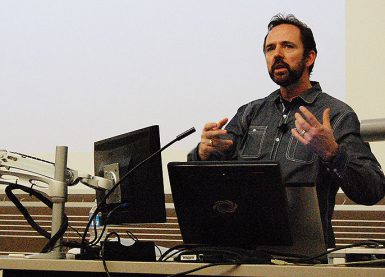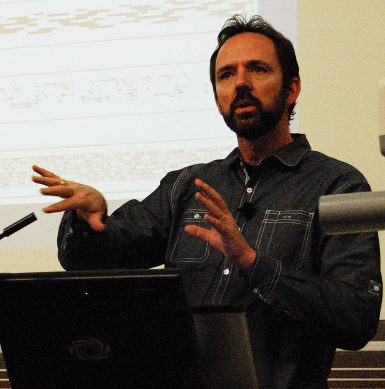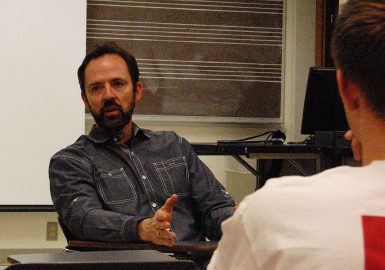Video game music composer Chance Thomas shares techniques, advice

Stunning visuals and a great story are paramount to any video game, but without a musical score to back it up, the emotional connection with the player is lost.
That’s where award-winning video game music composers like Chance Thomas come in.
Thomas talked to musicians and video game enthusiasts alike at the IU Jacobs School of Music on Monday about techniques for creating compelling music for video games. He later participated in a Q&A session, where he gave career advice and tips for breaking into the video game music industry.
The talk was hosted by Jacobs School’s Center for Electronic and Computer Music and was co-sponsored by The Media School.
“Entertainment often provides an amped up version of reality,” Thomas said. “The goal of a music score is to take what the designer intends and ratchet it up.”
But Thomas said it is challenging for video game composers to create music that players want to listen to.
“If someone turns off the music in the game, you’ve lost the battle,” Thomas said.
So Thomas showed still images to the crowd and asked them to describe what sort of music might accompany them. Audience members suggested soft orchestral strings, a choir or soft flutes for a pastoral scene with rolling hills and a sunset in the distance.
It’s similar to what Thomas had in mind, but he played a track very different from what the audience described. It was darker and foreboding, suggesting danger could be near.
“Music score is the emotional sub-narrative of any visual medium,” Thomas said.

Although music can accentuate the visuals, it can completely change how a player feels.
Thomas said the video game music is made up of “tinker toys” that serve as the building blocks to connect scenes. There are intro blocks, loops, transition blocks, stingers, cinematics and tags.
Most gamers don’t recognize those elements because they’re skillfully intertwined. For example, an intro block plays at the initial screen of a video game to set the mood. An action roleplaying game might play something that sounds medieval in its loading screen.
Transition blocks try to keep the player engaged. They play during a loading screen to stave off boredom.
When blocks are layered together, they make a score. A stinger, a piece of music that represents an important event, could happen at the end of a loop of music, leading to a cinematic cut scene, which leads to a tag, which marks the end of an event.
Thomas said that video game music has to set the mood, heighten emotions and propel the action.
Thomas gave examples of games he has worked on, such as The Lord of the Rings Online: Riders of Rohan (2012), and Peter Jackson’s King Kong: The Official Game of the Movie (2005), both of which won awards from video game publications.
During the Q&A, he told students that developing music for those games was sometimes difficult because there’s often a gap between the vision of a video game design team and the composer.
Thomas said that’s because developers are on tight budgets and don’t think to get the composer involved early. Composers rarely are given much to go on other than a basic theme. What’s worse is they’re only given a couple of months to produce several hours of music.
The room collectively gasped when Thomas revealed such a deadline.
“The best inspiration comes with the best information,” Thomas said. He wants aspiring game developers to see the industry from the eyes of a composer.
Even when a composer has access to the best information and the most advanced resources, Thomas said it still comes down to the basics.
“What do you think is the most important and valuable technology you’ll ever have access to as a score composer?” Thomas asked.

Students responded, saying a pencil, a keyboard, a computer or a sample library, an archive of musical sounds composers use to make music, would be most valuable.
One person in the back of the room tentatively offered, “Your brain?”
“Thank you!” Thomas said, clapping. “That’s it.
“This is the workshop of the imagination,” Thomas said, pointing his finger to his head. “It all happens here, folks.”
Ari Fisher, a graduate student in music composition, said the lecture gave him ideas to approach his own creative work.
“It’s very enlightening,” Fishers said. “This gave me some insight to my options in layering. He introduced some ideas that I’ve never thought of before.”
More:

